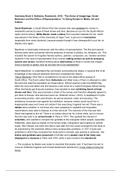Summary Book 6. Buikema, Rosemarie. 2018. “The Arena of Imaginings: Sarah
Bartmann and the Ethics of Representation.” In Doing Gender in Media, Art and
Culture
Sarah Baartman: a South-African Khoi-San woman who was exhibited for money in
nineteenth-century Europe at freak shows and fairs. Became an icon for the South-African
nation and its history. Willie Bester made a statue from recycled materials for her, which
was placed in the library of the University of Cape Town. It got a lot of commotion
(especially from many students), because people thought it was disrespectful to put her on
display once again.
Baartman is inextricably interwoven with the ethics of representation. The first and second
feminist wave were concerned with the presence of women in politics, art, literature, etc. This
included the search for forgotten female authors, painters, composers, etc. Gender sensitive
research in the area of representation thus involves adding women as well as analysing
sexism and racism, therefore thinking about alternatives to these in words and images.
Once a woman is added, how do we want her to be represented?
Sarah Baartman: to understand the commotion surrounding her statue, it requires first of all
knowledge of the relevant elements that have constituted her history.
-About Baartman: Khoi-San is considered to be one of the oldest ethnic groups of
South-Africa. The Dutch called them Hottentots and killed many of them in attempts to claim
the land and used the population as cheap labour. African warriors under the British flag
killed her lover and father and she became a wet nurse for a mixed European-African family.
When that family got financial problems, they decided to start exhibiting Sarah at freak
shows and fairs. She was promised a share of the money and therefore allegedly agreed to
join them to Europe. She become known as ‘Hottentot Venus’ (1810). It capitalised 2 myths
surrounding women, alien and deviant, as well as physical, erotic and arousing. The
antislavery movement was against her exhibition, because visitors would touch her in
inappropriate ways and it was not certain if she was doing it against her will. There was a
debate about whether or not those who were subjected to capitalist and imperialist
machinations were able to dispose of a free will at all. The outcome of the trial was that
Sarah had agreed to this all. There is no history about her for a short while, but it is known
that she was sold to an animal trader in Paris in 1814. This sparked the interest of
scientists, who wanted to compare her genitalia to the orangutan (black people, especially
Hottentots, were seen as lowest on the human scale, orangutans were highest on animal
scale). She refused, but when she died a year later her new owner arranged for her body to
be examined by the scientists without many bureaucratic problems. In 1817 a book was
published in which they compared her body parts to animals, ape species in particular. Her
brains and genitalia were preserved in formalin and a plaster cast of her body was
displayed in a museum in Paris until 1976, when it was moved to the stockroom.
→ The sculpture by Bester was made to resemble that plaster cast. It had been his aim to
voice an indictment against such forced banishment (stockroom), it was made to bring her
home.





